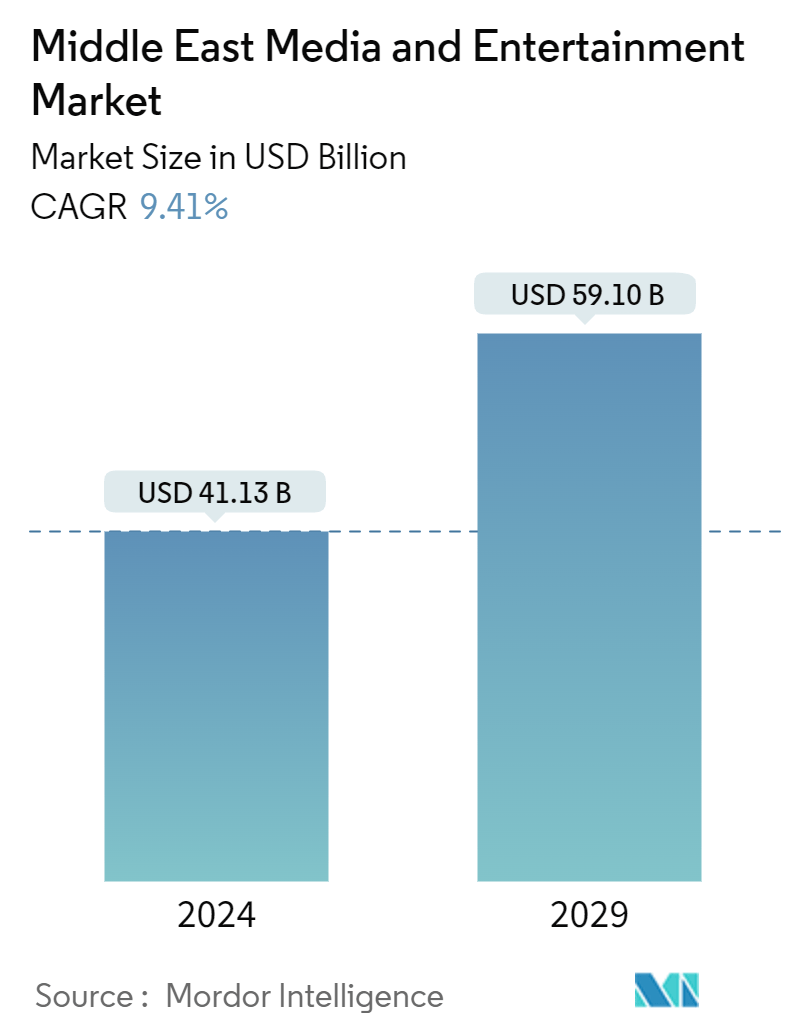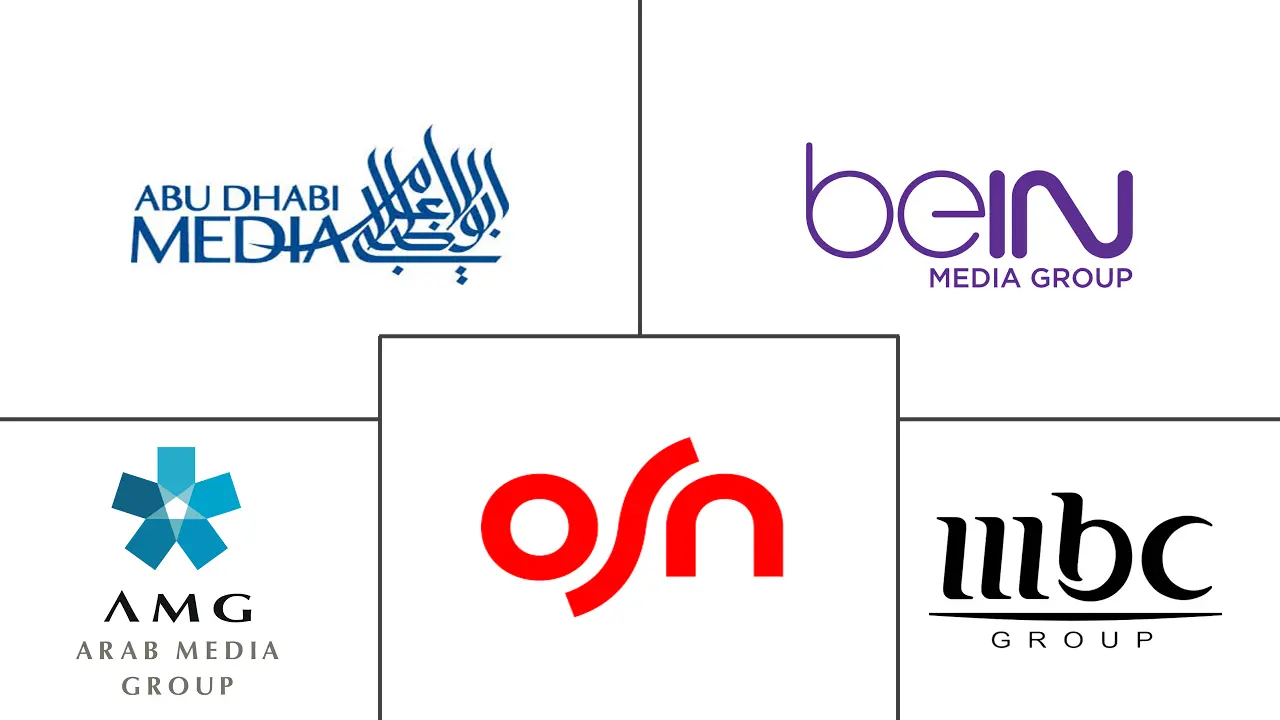Market Size of Middle East Media And Entertainment Industry

| Study Period | 2019 - 2029 |
| Base Year For Estimation | 2023 |
| Market Size (2024) | USD 41.13 Billion |
| Market Size (2029) | USD 59.10 Billion |
| CAGR (2024 - 2029) | 9.41 % |
| Market Concentration | Low |
Major Players
*Disclaimer: Major Players sorted in no particular order |
Middle East Media and Entertainment Market Analysis
The Middle East Media And Entertainment Market size is estimated at USD 41.13 billion in 2024, and is expected to reach USD 59.10 billion by 2029, growing at a CAGR of 9.41% during the forecast period (2024-2029).
- The media and entertainment (M&E) industry has been one of the first business sectors to fuel digital disruption, and its transformation is far from over. As critical networks and studios continue to unveil their direct-to-consumer streaming facilities, players are likely to scramble to propose content libraries wide enough to both attract and hold customers, permitting and generating chances and opportunities for media and entertainment companies to re-aggregate their content libraries with a comprehensive collection of offerings, from music, video, and gaming services to ad-supported content.
- The Middle Eastern media and entertainment industry is witnessing rapid transformation. There have been cultural shifts among the region’s young people, creating a significant demand for a wide range of media and entertainment content. This untapped demand for local Arabic content is poised to spur the growth of the regional media. The increased adoption of mobile technology has created significant opportunities across media platforms.
- Moreover, evolutions in paid and digital media have created new investment rationales. These changes allow regional media players to reset their business models, seek investments in high-quality local content, and offer global players, in particular, a reason to re-assess their presence in the region.
- Piracy and copyright enforcement are major challenges faced by the Middle Eastern entertainment industry. In the digital landscape, where content is easily pirated or copied, distributed, and accessed without authorization, the industry incurs heavy losses in its revenue. Piracy undermines the enforcement of intellectual property rights, making it difficult for content creators and distributors to protect their work from unauthorized duplication and distribution. This decline in intellectual property rights affects revenue and also discourages investment in new projects and talent development.
- For the media and entertainment market in the Middle East, the post-COVID-19 period has brought about a paradigm shift. The industry landscape has changed due to the rapid digital revolution, shifting customer behavior, and creative business strategies. Stakeholders may effectively manage the dynamic landscape and leverage the increasing need for immersive and engaging entertainment experiences in the Middle East and beyond by adopting a digital innovation-driven approach, diversifying their content investments, and utilizing emerging technologies.
Middle East Media and Entertainment Market Segmentation
In order to entertain and inform audiences, media and entertainment are industries that encompass a range of activities relating to the creation, production, distribution, and consumption of content. It includes a vast range of media such as television, film, music, radio, newspaper, video games, live performances, and digital media. The media industry consists of the production and dissemination of news, information, or entertainment.
The market study emphasizes the trends impacting the media and entertainment industry across the major countries of the Middle Eastern region. The study highlights the key market parameters, underlying growth influencers, and major vendors operating in the industry. The study also tracks the impact of COVID-19 on the region's overall media and entertainment industry.
The Middle East media and entertainment market is segmented by type (digital music (music downloads and music streaming), video games, video-on-demand (SvoD and TVoD, video downloads), e-publishing, advertising (digital advertising, newspaper, magazine, television, radio, and outdoor advertising), and internet access) and country (Saudi Arabia, United Arab Emirates, Qatar, and the Rest of Middle East). Market sizes and forecasts are provided in terms of value (USD) for all the above segments.
| By Type | ||||||||
| ||||||||
| Video Games | ||||||||
| ||||||||
| E-publishing | ||||||||
| ||||||||
| Internet Access |
| By Country*** | |
| Saudi Arabia | |
| United Arab Emirates | |
| Qatar |
Middle East Media And Entertainment Market Size Summary
The Middle East media and entertainment industry is undergoing a significant transformation, driven by digital disruption and evolving consumer preferences. The sector is experiencing rapid growth, fueled by increased internet access and the widespread adoption of mobile technology. This has led to a surge in demand for diverse media content, particularly local Arabic offerings, which are expected to propel the market forward. The region's media landscape is becoming increasingly competitive, with both regional and international players vying for market share. The rise of direct-to-consumer streaming services and the expansion of digital platforms are reshaping business models, encouraging investments in high-quality local content, and attracting global players to reassess their presence in the region.
Despite the promising growth prospects, the industry faces challenges such as piracy and copyright enforcement, which undermine revenue and deter investment in new projects. The post-COVID-19 era has accelerated the shift towards digital media, with stakeholders leveraging emerging technologies to enhance user engagement and offer immersive experiences. Government initiatives, such as Saudi Arabia's Vision 2030, are boosting internet connectivity and supporting the sector's expansion. The market is characterized by a degree of consolidation, with major players like MBC Group, Orbit Showtime Network, and beIN Media Group dominating the landscape. Recent partnerships and collaborations, such as Intigral's alliances with Sandbox Group and Moonbug Entertainment, highlight the ongoing efforts to diversify content offerings and cater to the region's growing digital audience.
Middle East Media And Entertainment Market Size - Table of Contents
-
1. MARKET INSIGHTS
-
1.1 Market Overview
-
1.2 Industry Attractiveness - Porter's Five Forces Analysis
-
1.2.1 Threat of New Entrants
-
1.2.2 Bargaining Power of Buyers
-
1.2.3 Bargaining Power of Suppliers
-
1.2.4 Threat of Substitutes
-
1.2.5 Intensity of Competitive Rivalry
-
-
1.3 Industry Value Chain Analysis
-
1.4 Assessment of the Impact of COVID-19 on the Market
-
-
2. MARKET SEGMENTATION
-
2.1 By Type
-
2.1.1 Digital Music
-
2.1.1.1 Music Downloads
-
2.1.1.2 Music Streaming
-
-
2.1.2 Video Games
-
2.1.3 Video-on-demand
-
2.1.3.1 SvoD
-
2.1.3.2 TVoD
-
2.1.3.3 Video Downloads
-
2.1.3.4 Video Downloads/EST
-
-
2.1.4 E-publishing
-
2.1.5 Advertising
-
2.1.5.1 Digital Advertising
-
2.1.5.2 Newspaper
-
2.1.5.3 Magazine
-
2.1.5.4 Television
-
2.1.5.5 Radio
-
2.1.5.6 Outdoor Advertising
-
-
2.1.6 Internet Access
-
-
2.2 By Country***
-
2.2.1 Saudi Arabia
-
2.2.2 United Arab Emirates
-
2.2.3 Qatar
-
-
Middle East Media And Entertainment Market Size FAQs
How big is the Middle East Media And Entertainment Market?
The Middle East Media And Entertainment Market size is expected to reach USD 41.13 billion in 2024 and grow at a CAGR of 9.41% to reach USD 59.10 billion by 2029.
What is the current Middle East Media And Entertainment Market size?
In 2024, the Middle East Media And Entertainment Market size is expected to reach USD 41.13 billion.

